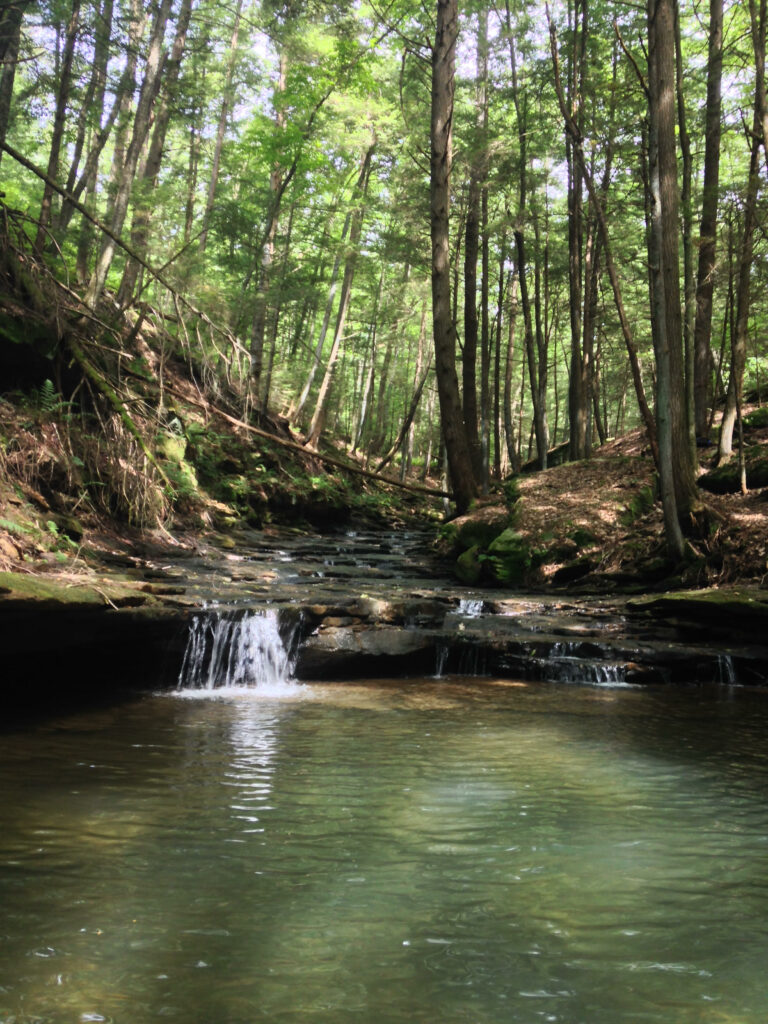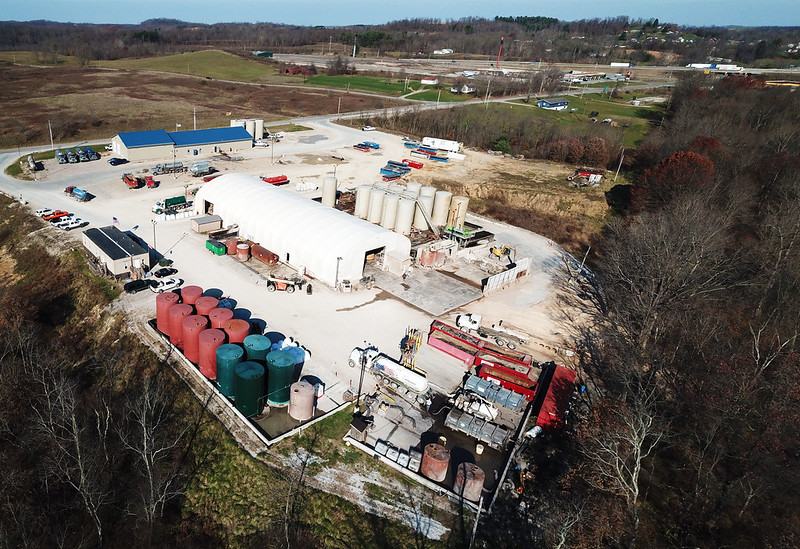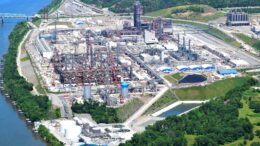The Place:
The Allegheny Plateau is a lower-lying portion of the Appalachian Mountain Range that extends from southern and central New York to northern and western Pennsylvania, eastern Ohio, northern and western West Virginia, and eastern Kentucky.
Why it matters:
The plateau consists of areas of gently sloping hills in the north and west of the region as well as rugged valleys in the south and east. It overlies the Marcellus Shale and Utica Shale, sedimentary rock formations. The region is rich in natural resources, including hardwoods, iron ore, silica, coal, oil and natural gas.
The abundance of these resources supported development in the region and were integral to the local steel, glass, rail and extraction industries.
Prior to widespread logging between 1890 and 1920, the area hosted old-growth forests containing red spruce, eastern white pine, eastern hemlock, sugar maple, black oak, white oak, yellow birch and American beech.
But the forest’s makeup is now different, favoring oaks, maples, hickories, American beech and yellow birch. Though fragmented and much less mature than the old-growth forests, today’s forests continue to play a vital role in ecosystems, serving as habitats for the federally endangered Indiana bat as well as locally endangered or at-risk species such as little brown bats, northern flying squirrels and blackpoll warblers.

The region hosts the Ohio River watershed and confluence, the Allegheny National Forest in New York and Pennsylvania, and the Wayne National Forest in Ohio.
The threat:
Unconventional oil and gas development has boomed in the region over the past decade. The U.S. Geological Survey estimates that the Marcellus and Utica shale plays contain approximately 214 trillion cubic feet of recoverable natural gas, making the Allegheny Plateau a lucrative location for hydraulic fracturing, or “fracking.”
Already more than 13,000 unconventional wells have been drilled in Pennsylvania. Fracking itself is a resource intense process, requiring between 2 and 20 million gallons of water per well. A 2014 study estimated that in Pennsylvania, 80% of the water used for fracking comes from streams, rivers, and lakes, thus potentially altering water temperature and levels of dissolved oxygen. This water is combined with sand and a mixture of hazardous chemicals, which may include methanol, ethylene glycol and propargyl alcohol.
Between 20-25% of the water that is injected into the well returns to the surface. This flowback water often has higher salinity and has been known to contain barium, arsenic, benzene and radium. While recycling of flowback is becoming more common, other methods of disposal include underground injection, application to road surfaces, treatment at public waste facilities, and discharging it onto rivers, streams and lakes.
Near fracking sites in West Virginia, elevated levels of barium and strontium were found in feathers of Louisiana waterthrushes, native songbirds who make their home in brooks and wooded swamps. In northwestern Pennsylvania, crayfish and brook trout living in fracked streams were found to have increased levels of mercury. Fish diversity is also reduced in streams that have been fracked.
Fracking consumes land, too. Each fracking well requires 3-7 acres. In Pennsylvania over 700,000 acres of state forest land are leased or available for gas production. Well pads, pipelines and other fracking infrastructure fragment forests, alter their ecology, and reduce biodiversity. Appalachian azure butterflies and federally threatened northern wild monkshood — purple-flowering herbaceous perennials found in New York and Ohio — are both sensitive to forest fragmentation.
In addition to the direct impacts of fracking, the availability of natural gas in the Marcellus and Utica shale plays attracts petrochemical development to the region. Shell Polymers Monaca initiated operations in November 2022 at a newly constructed 386-acre petrochemical complex in southwestern Pennsylvania, along the Ohio River.
The plant manufactures virgin polyethylene pellets, which will be largely be used for production of single-use plastic products. In addition to releasing hazardous air pollutants, volatile organic compounds and particulate matter, this ethane “cracker” plant will emit 2.2 million tons of carbon dioxide per year.
The plant’s existence will also fuel fracking in the region; it is anticipated that it will require between 100 and 200 new wells each year in order to supply natural gas for its productions. Other petrochemical companies, including Exxon, PTT Global and Odebrecht, have reportedly been considering building similar complexes in Pennsylvania, Ohio and West Virginia.

Photo: Ted Auch, FracTracker Alliance. (CC BY-NC-ND 2.0)
My place in this place:
I was born and raised in the area, and my family’s roots in southwestern Pennsylvania go back several generations. Some of my most cherished memories involve Pennsylvania’s forests, rivers and streams. As a child I loved my family’s summer pilgrimages to our cabin, a rustic building that had been converted from a one-room schoolhouse in the Pennsylvania Wilds. At “camp” we fished for yellow perch, smallmouth bass and walleye in the Sinnemahoning Creek and caught crayfish by hand. We sunned ourselves on the rocks along the river bank when the water was warm. In the evenings we walked on quiet, narrow roads in hopes of spotting an eastern elk in a grassy field.
I now live in Beaver County, Pennsylvania, one mile from the Shell cracker plant. I can observe the plant’s flaring from my kitchen window, which often creates an ominous orange glow in the night sky. To me the plant doesn’t symbolize job creation or a rebounding local economy, despite the assertions of local and state politicians. I see the plant as the perpetuation of a hopeless dependence on fossil fuels and corporate profit at the expense of ecological integrity. I worry that fracking and an associated petrochemical buildout will destroy already fragile ecosystems throughout my home in the Allegheny Plateau.
Who’s protecting it now:
There are a variety of environmental groups located in the region. No Petro PA is an organization that resists fracking and pipeline development in Pennsylvania, Ohio and West Virginia. More locally the Beaver County Marcellus Awareness Community in western Pennsylvania opposes fracking and seeks to protect local community members from its harmful effects.
With the rise of the Shell cracker plant, the group also formed Eyes on Shell, a community organization that aims to hold Shell accountable for its activity and advocates for the surrounding communities’ health and safety. These are just three of the many grassroots organizations working to protect the air, soil, water, wildlife and communities in the region.
The national organization, FracTracker, also provides extensive data on oil and natural gas wells, pipelines, legislation and environmental health.
What this place needs:
Ideally Ohio, Pennsylvania and West Virginia will follow in the footsteps of New York and institute a ban on fracking in light of the environmental and health risks associated with unconventional gas and oil development. However, given their strong ties to the fossil fuel industry, it is unlikely that this will occur. Banning fracking on public land in the region, such as in state forests and county parks, in a practical first step in combatting forest fragmentation and pollution.
At a regional level, regulations should be put in place to protect the water quality of the Ohio River. The Ohio River Valley Water Sanitation Commission, a multistate organization working with the federal government, could ban fracking in the Ohio River Basin in order to protect the river and its watershed. The Delaware River Basin Commission has successfully prohibited fracking within the Delaware River Basin; the rules developed by the commission could be adapted for use by the Ohio River Valley Water Sanitation Commission.
Additional government oversight would help to protect water quality in the region. Presently fracking is exempt from the Safe Water Drinking Act and therefore isn’t regulated by the U.S. Environmental Protection Agency. Ending this exemption could increase water quality and safety within the Allegheny Plateau.
Increased transparency from oil and gas companies is also required to protect the region’s water. As of July 2022, California is the only state in the country that requires full public disclosure of all chemicals used in fracking. Pennsylvania, West Virginia and Ohio must implement policies that require full public disclosure of chemicals used in all phases of the fracking process.
Previously in The Revelator:
We’re Just Starting to Learn How Fracking Harms Wildlife


